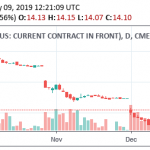
In 2016, the U.S. Dairy Export Council (USDEC) devised a plan we called “The Next 5%.” It was a set of strategies and tactics aimed at providing a foundation for U.S. dairy suppliers to build U.S. dairy exports from the equivalent of about 15 percent of U.S. milk solids to 20 percent.
McKnight (2)In 2018, the first full year of that plan, the industry used that foundation to build the first floor. Through 10 months, U.S. dairy exports were equal to about 16.3 percent of U.S. milk solids, a record. By comparison, exports in 2017 were 14.7 percent of milk solids; the previous high was 15.5 percent in 2013.
How far we get in completing the building in 2019 is the subject of this article. What follows is not a forecast of U.S. growth expectations, but rather eight signposts that will shape market opportunities and direction in the year ahead.
1. Efforts to remove retaliatory tariffs.
A report from Texas A&M’s Center for North American Studies forecast U.S. dairy export losses from Chinese and Mexican retaliatory tariffs as high as $800 million per year, resulting in U.S. dairy farmers losing up to $2.8 billion per year due to lost sales and lower milk prices. We are already seeing erosion in the U.S. position in China in skim milk powder, whey and cheese, and slower growth for U.S. cheese in Mexico.
USDEC has made the dangers clear in comments to the U.S. government, letters to policymakers and meetings with officials. We are hopeful for a resolution with Mexico, where the retaliatory tariffs are specifically related to U.S. Section 232 tariffs on steel and aluminum. China’s retaliatory tariffs, however, are related to much broader U.S.-China economic differences and likely will take more time to resolve.
On the plus side, after months of stalemate, U.S. and Chinese leaders came to a temporary truce in December, agreeing to postpone additional tariff hikes that were set to kick in Jan. 1, 2019. The two sides are back at the bargaining table and have set a March 2, 2019, deadline to reach a deal and avert further escalation of the trade conflict.
The retaliatory tariffs won’t grind all U.S. dairy exports to a halt and, on their own, do not doom growth aspirations. Indeed, U.S. suppliers have had some success redirecting product to other markets, like Southeast Asia. But the tariffs make us less competitive in two critical markets and heighten the challenge of getting to The Next 5%.
2. Impact of supply and demand realignment.
The main anchor to dairy expansion over the past two years has been oversupply: Aggregate milk production growth from the major supply regions around the world has outpaced global demand, exacerbated by 380,000 tons of skim milk powder (SMP) languishing in EU intervention. In 2019, that market anchor is poised to be hoisted.
Collective milk production growth from the four largest global dairy suppliers (Australia, the EU, New Zealand and the United States) eased significantly in the second half of 2018, the result of poor weather, fodder shortages and rising margin pressure for most farmers.
Historically, milk production from those four has increased about 1.5 percent per year. This year it will be less than 1 percent. In the first half of 2019, we could see growth close to flat—a rare occurrence.
Aided by strong overseas demand, the EU executed an orderly and minimally disruptive draw-down of intervention stocks in 2018, selling more than 277,000 tons. We expect the remaining 100,000 tons, mostly older product, to exit intervention bound for the animal feed sector over the first quarter of 2019. The last time EU SMP intervention stocks were at zero was mid 2015.
Supply conditions are setting up to be markedly different than the past two years. Should demand continue as expected (U.S. NDM/SMP exports soared 25 percent over the first 10 months to 617,095 tons, a new annual record with two full months to go), we could see markets tighter than they have been for quite a while.
For example, expectations for continued steady demand for SMP without the backdrop of the EU stockpile could see U.S. NDM/SMP prices averaging above $2,000/ton in the coming year, a level unseen since a brief spike in mid 2017.
3. USMCA approval and implementation.
While USDEC argued for deeper market expansion and stronger dairy disciplines on Canada in the U.S.-Mexico-Canada Agreement (USMCA), the deal meets the biggest U.S. dairy objectives. It maintains the overall U.S.-Mexico trading structure of the 24-year-old North American Free Trade Agreement (NAFTA) while incorporating new commitments to strengthen U.S. dairy export prospects throughout the North American region, including scrapping Canada’s trade- distorting Class 6 and 7 milk pricing schemes and tackling the misuse of geographical indications to restrict U.S. cheese trade.
Whether the beneficial provisions of USMCA foster U.S. dairy export growth in 2019 lies in part with the deal’s congressional approval and implementation.
Approval in 2019 is not assured, and the path forward is filled with unknowns, including what might happen should President Trump follow through on threats to withdraw from NAFTA prior to a USMCA vote.
The ultimate impact of the agreement will depend on how it is then subsequently implemented by the three countries involved.
The U.S. dairy industry will engage with both parties in Congress to seek their support for the agreement’s passage while at the same time seeking assurances that Canada will comply with its commitments in a fair and transparent manner.
4. Progress on other U.S. trade talks as competitors implement new deals.
To ensure U.S. dairy suppliers remain competitive, it is critical that the United States accelerate efforts to pursue bilateral negotiations with high-potential markets like Japan, the UK, Vietnam and other agriculture importers. The Trump administration announced its intention to start talks with Japan, the UK and the EU in 2019 (although EU and U.S. officials have yet to agree on agriculture’s role in the EU talks and Brexit uncertainty overhangs the prospect of talks with the UK) and expressed a desire to establish a model trade agreement with a nation in Africa.
U.S. headway on new trade deals is so important because our competitors are not only aggressively pursuing new deals, they are implementing two pacts in key U.S. dairy export markets this year. The Comprehensive and Progressive Trade Agreement for Trans-Pacific Partnership (CPTPP)—which includes Australia, New Zealand, Canada, Japan, Mexico, Vietnam and others—went into effect on December 30, 2018, to allow Year 2 tariff levels to kick in in 2019. The new EU-Mexico trade agreement is expected to enter into force soon.
One of the big questions for 2019 is: How quickly will markets shift in response to these competitors’ trade deals?
The other big question is: Even though trade negotiations can take considerable time to finalize, will we see U.S. progress in advancing talks with Japan and other markets to match or counter our competitors’ efforts?
5. Global economic growth.
Strong demand driven by a robust global economy was a big reason behind this year’s record U.S. dairy exports. The recovery in oil prices, which began ramping up at the end of 2017 until they peaked in mid-2018, was particularly helpful in reviving demand from oil-producing nations.
For 2019, the economic picture is growing cloudier. To start, oil prices began to tumble again in the fourth quarter on concerns of oversupply and worries over the global economy. They ended the year well down from the 2018 peak.
Groups like the International Monetary Fund, the World Bank and the World Trade Organization are all sounding warning bells on trade and economic growth. Economic indicators from individual countries—China, Germany, Japan—point to what Federal Reserve Chairman Jerome Powell called “a bit of a slowdown” that is “concerning.”
At the same time, Rabobank warned that geopolitical tension, the El Niño weather system and the potential spread of livestock diseases suggest higher world food prices in 2019. Coupled with slower economic growth, they could provide some dairy demand headwinds.
6. Chinese dairy consumption.
China dairy imports grew more than 7 percent by volume over the first 11 months of 2018, compared to the same period the previous year. It was another strong year for the world’s largest dairy buyer.
The country purchased 2.6 million metric tons of dairy over that period, nearly 180,000 metric tons more than the first 11 months of 2017—a record pace. Most major product categories posted gains: WMP imports rose 7 percent; SMP grew 10 percent; whey increased 7 percent; butter jumped 30 percent; and lactose soared 35 percent. Cheese fell 3 percent, one of the few to see a decline.
China continues to drive global dairy trade, even though second-half buying slowed. Much will depend on China’s economic health in 2019, but if the nation imports are up 5-10 percent again (as many expect they could be), coupled with tighter supply and little to no stock overhang, we could be in for a sizable shift in market sentiment in the second half of the year.
7. Global cheese demand direction.
The world’s cheese suppliers—particularly in New Zealand, the EU and the United States—have been gearing for export growth by investing in new cheese capacity for some years now. No one doubts that demand growth is imminent, but those expecting it in 2018 faced some disappointment.
Cheese exports from the top 20 suppliers declined 0.4 percent in the first 10 months of the year, compared to January-October 2017. New Zealand shipments were down 7 percent and EU exports were up only 0.4 percent over that period. Given the flat market, the U.S. export gain of 3 percent (in the face of retaliatory duties in China and Mexico) looks like a healthy showing.
The United States, in fact, was on track to retake the crown as the largest single-country cheese exporter in the world through the first 10 months of 2018—a title that alternated between the U.S. and New Zealand since 2014.
In 2019, pending other factors such as global economic development, we expect to see global cheese demand growth recover and will watch if U.S. suppliers can continue to build share even as they face retaliatory tariffs and other hurdles to cheese trade like restrictive geographical indications.
8. Brexit progress and fallout.
With less than three months until the Brexit deadline, the UK and the EU have yet to finalize the terms of their divorce. The two agreed to a tentative deal but that deal faces so much opposition from Britain’s Parliament that most experts are certain it will not pass.
Should it (or a replacement) fail to pass, the UK could try to extend the March 31, 2019, deadline or face a “no deal” or “hard” Brexit. Either way, what happens will have a ripple effect on global dairy markets and U.S. export ambitions. Uncertainty abounds, but the eventual outcome could:
Impact and possibly displace up to $4 billion in dairy products exported each year from Ireland to the UK and about $1.7 billion from the UK to Ireland.
Upend operations at Irish dairy processors—aggressive global exporters—who currently utilize about 800 million tons of raw milk annually from Northern Ireland to run their plants.
Limit the UK’s freedom to negotiate free trade deals outside the EU, including one with the United States.
Limit the UK’s right to make independent decisions about geographic indications, potentially limiting U.S. and other non-EU cheese exports to the UK.
Impact how tariff rate quotas are handled for shipments to the EU and UK, hindering export efforts to both.
With the deadline looming at the end of the first quarter, we won’t have long to wait to learn more.
Matt McKnight is Chief Operating Officer at the U.S. Dairy Export Council.

























